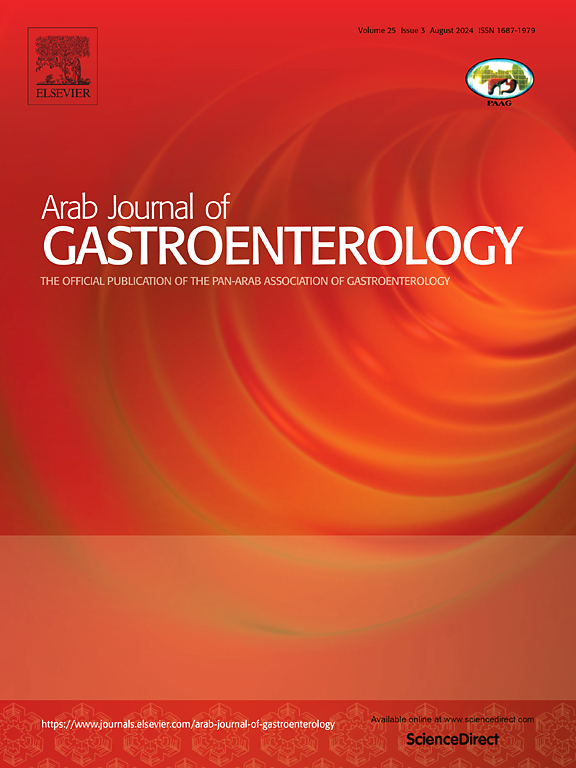Risk factors and correlation of intestinal metaplasia: A case- control study in Wuwei
IF 1.1
4区 医学
Q4 GASTROENTEROLOGY & HEPATOLOGY
引用次数: 0
Abstract
Background
Intestinal metaplasia (IM) is a significant gastric mucosal change that warrants attention due to its potential role in the pathogenesis of gastric cancer. IM is often triggered by Helicobacter pylori (H. pylori) infection and some risk factors.
Patients and methods
This study examined H. pylori infection and related risk factors in 7,096 participants, identifying 2,200 cases of IM linked to H. pylori and 4,896 controls without the infection in Wuwei, Gansu Province, China. The Operative Link on Gastritis/Intestinal Metaplasia (OLGIM) and (Operative Link on Gastritis Assessment (OLGA) classifications tools were used for identifying participants at high risk for gastric cancer by evaluating the severity and extent of H. pylori infection and IM.
Results
The study found that IM and H. pylori prevalence were gender-related, with males representing 41.09 % of cases compared to 33.92 % of controls, a significant difference (P < 0.0001). Conversely, females were more prevalent in the control group (66.07 %) compared to the case group (58.91 %). Age analysis showed higher proportions of IM cases in the 40–49 years group (46.95 %) compared to controls (43.40 %), with significant differences across age groups (P < 0.0001). IM showed significant positive correlations with smoking , alcohol consumption , and drinking water sources . H. pylori infection was detected in 238 (10.81 %) of the case group and 542 (11.07 %) of the control group. Using the OLGIM classification, which incorporates IM into gastric cancer risk assessment, stage 0 (no IM) was observed in 1,189 (24.28 %) of the control group and 530 (24.09 %) of the case group. Stage 1 (mild IM) was found in 3,165 (64.62 %) of the controls and 1,432 (65.09 %) of the cases. Stage 2 (moderate IM) was present in 520 (10.62 %) of the controls and 220 (10 %) of the cases, while stage 3 (severe IM) was observed in 24 (0.49 %) of the controls and 18 (0.82 %) of the cases. For OLGA staging, the case group had a higher percentage of individuals in higher stages (III and IV) compared to the control group. Specifically, 50.84 % of the cases were classified as stage 0, 19.75 % , stage I, 14.71 %, stage II, 8.40 %, stage III, and IV, 6.30 %. In the control group, 54.43 % were classified as stage 0, 24.17 %, stage I, 18.45 %, stage II, 1.66 %, stage III, and IV, 1.29 % respectively.
Conclusions
These findings suggest that older individuals, males, smokers, drinkers, and those using certain drinking water sources are more likely to develop IM. The study highlights the combined impact of H. pylori and risk factors on IM development, emphasizing the need for comprehensive public health strategies to address these risks. The higher proportion of advanced OLGA stages in the case group suggests more severe gastric atrophy, potentially indicating a higher risk for gastric cancer development.
武威市肠化生危险因素及相关性的病例对照研究。
背景:肠上皮化生(IM)是一种重要的胃粘膜改变,因其在胃癌发病机制中的潜在作用而值得关注。IM通常由幽门螺杆菌感染和一些危险因素引发。患者和方法:本研究检查了7096名参与者的幽门螺杆菌感染及相关危险因素,确定了2200例与幽门螺杆菌相关的IM病例和4896例未感染的对照。使用胃炎/肠化生手术链接(OLGIM)和胃炎评估手术链接(OLGA)分类工具,通过评估幽门螺杆菌感染和IM的严重程度和程度来识别胃癌高风险参与者。结果:研究发现,IM和幽门螺杆菌患病率与性别有关,男性占41.09%,对照组占33.92%,差异有统计学意义(P < 0.0001)。相反,女性在对照组(66.07%)比病例组(58.91%)更普遍。年龄分析显示,40-49岁组IM病例比例(46.95%)高于对照组(43.40%),年龄组间差异有统计学意义(P < 0.0001)。IM与吸烟、饮酒和饮用水源呈显著正相关。病例组238例(10.81%)幽门螺旋杆菌感染,对照组542例(11.07%)。使用将IM纳入胃癌风险评估的OLGIM分类,对照组1189例(24.28%)和病例组530例(24.09%)观察到0期(无IM)。3165例(64.62%)的对照组和1432例(65.09%)的病例出现1期(轻度IM)。对照组520例(10.62%)和病例220例(10%)出现2期(中度IM),对照组24例(0.49%)和病例18例(0.82%)出现3期(重度IM)。对于OLGA分期,与对照组相比,病例组处于较高阶段(III和IV)的个体百分比更高。其中,0期50.84%,19.75%,I期14.71%,II期8.40%,III期6.30%,IV期6.30%。对照组分为0期54.43%,1期24.17%,1期18.45%,2期1.66%,3期1.29%,4期1.29%。结论:这些发现表明,老年人、男性、吸烟者、饮酒者和使用某些饮用水源的人更容易患IM。该研究强调了幽门螺杆菌和风险因素对IM发展的综合影响,强调需要制定全面的公共卫生战略来应对这些风险。病例组中较高比例的晚期OLGA阶段表明更严重的胃萎缩,潜在地表明胃癌发展的风险更高。
本文章由计算机程序翻译,如有差异,请以英文原文为准。
求助全文
约1分钟内获得全文
求助全文
来源期刊

Arab Journal of Gastroenterology
Medicine-Gastroenterology
CiteScore
2.70
自引率
0.00%
发文量
52
期刊介绍:
Arab Journal of Gastroenterology (AJG) publishes different studies related to the digestive system. It aims to be the foremost scientific peer reviewed journal encompassing diverse studies related to the digestive system and its disorders, and serving the Pan-Arab and wider community working on gastrointestinal disorders.
 求助内容:
求助内容: 应助结果提醒方式:
应助结果提醒方式:


